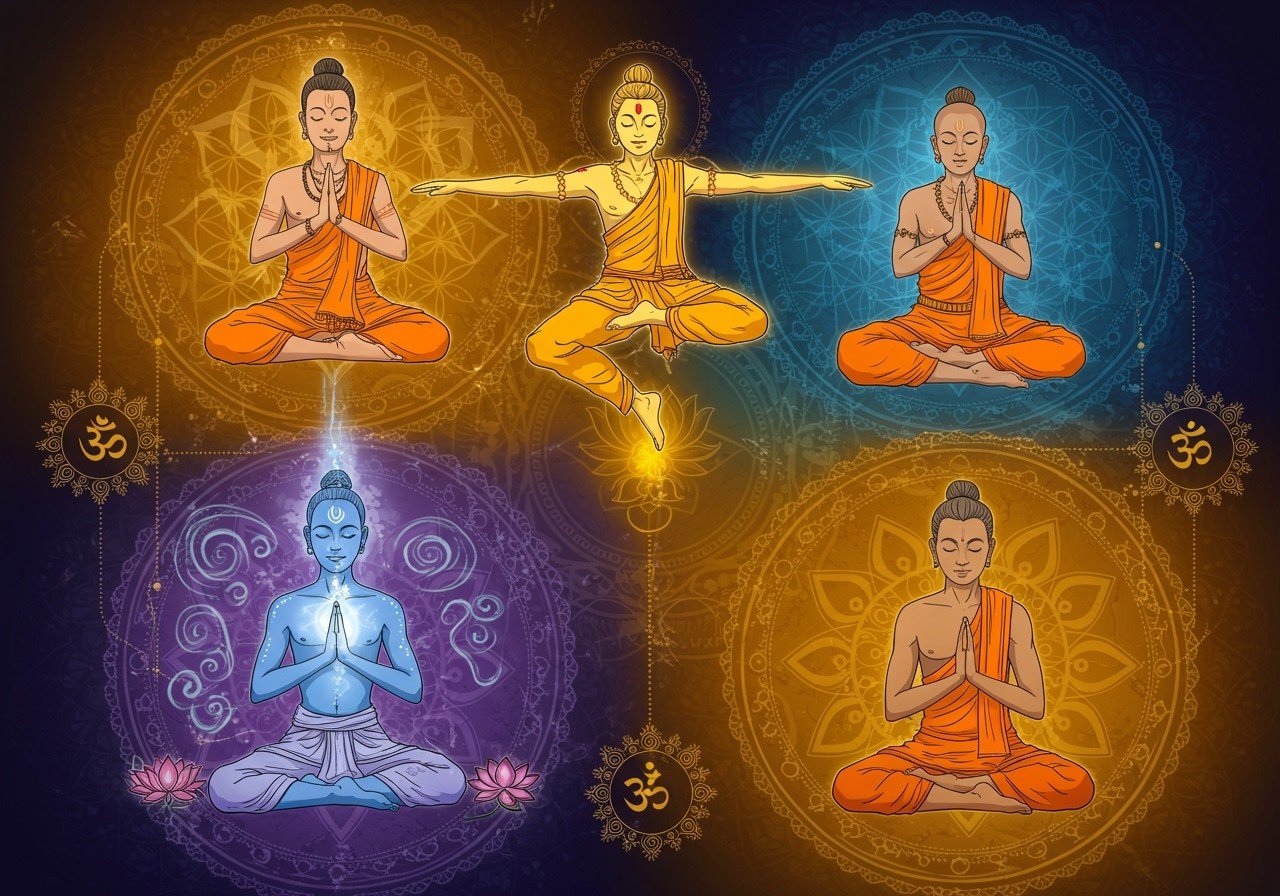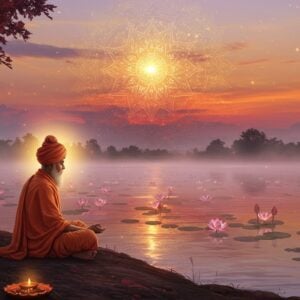Yoga Philosophy: A Journey Through Ashtanga, Hatha, and Sankhya

Yoga philosophy offers a profound exploration of human consciousness and spiritual evolution. Among its diverse paths, Ashtanga, Hatha, and Sankhya hold significant positions, each offering unique approaches to self-discovery and liberation. This exploration delves into the core principles of these schools, highlighting their distinctions and interconnections. For those seeking to deepen their practice, poojn.in offers a wide array of products and resources. Explore our collection of meditation cushions, yoga mats, and sacred texts to enhance your spiritual journey. Discover our curated Puja kits designed to support your chosen path.
Ashtanga Yoga: The Eightfold Path to Self-Realization
Rooted in Patanjali’s Yoga Sutras, Ashtanga Yoga presents an eight-limbed path (Ashtanga) designed to cultivate mental discipline and guide practitioners towards spiritual liberation.
- Yamas and Niyamas: These ethical precepts provide a moral compass for navigating both personal and interpersonal interactions, laying the groundwork for a life of integrity and self-awareness. They emphasize non-violence, truthfulness, non-stealing, continence, and non-possessiveness (Yamas). Niyamas focus on purity, contentment, self-discipline, self-study, and surrender to a higher power.
- Asana and Pranayama: Asana, the physical postures, cultivates strength, flexibility, and balance within the body, preparing the practitioner for deeper meditative practices. Pranayama, breath control techniques, regulate the flow of vital energy (prana), calming the mind and promoting inner tranquility. Together they create a harmonious foundation for spiritual growth.
- Pratyahara and Dharana: Pratyahara, the withdrawal of senses, involves detaching from external stimuli, turning the attention inwards. This practice cultivates a deeper connection with the inner self. Dharana, focused concentration, trains the mind to fix its attention on a single point, developing mental clarity and stability.
- Dhyana and Samadhi: Dhyana, meditation, is a state of sustained awareness, allowing the mind to transcend thoughts and experience profound stillness. Samadhi, the ultimate state of absorption, represents the union of individual consciousness with the divine, a state of blissful liberation. Explore our blog post on connecting with your inner self for more insights on meditation practices.
Ashtanga’s emphasis on discipline and structured practice has influenced dynamic styles like Vinyasa, characterized by flowing movements synchronized with breath. This approach offers a powerful pathway for those seeking holistic well-being, integrating physical strength with spiritual growth. At poojn.in, we provide high-quality yoga mats perfect for dynamic Ashtanga practices. Discover our range of yoga accessories here.
Hatha Yoga: Balancing Energies for Holistic Harmony
Hatha Yoga emphasizes the harmonization of opposing energies within the body and mind, represented by ‘Ha’ (sun) and ‘Tha’ (moon). Drawing from ancient texts like the Hatha Yoga Pradipika, this practice utilizes physical postures, breathwork, and cleansing techniques to achieve equilibrium and prepare the practitioner for deeper spiritual exploration.
- Asanas and Pranayama: Hatha Yoga employs physical postures (asanas) to purify the body, increase flexibility, and cultivate strength. Pranayama, breath control techniques, calms the mind, balances energy flow, and enhances vital energy. Together, these practices create a stable foundation for physical and mental well-being.
- Mudras and Bandhas: Mudras, hand gestures, and Bandhas, energy locks, are subtle yet powerful tools for directing the flow of prana within the body. These practices refine the energetic body, supporting deeper states of meditation and spiritual awakening. Learn more about Bhakti Yoga, the path of devotion, to enhance your understanding of spiritual practices.
Hatha Yoga’s accessibility and focus on holistic well-being have contributed to its widespread popularity, particularly in therapeutic applications. Its gentle yet powerful practices promote physical health, mental clarity, and spiritual growth. Enhance your Hatha Yoga practice with our collection of meditation cushions, designed for optimal comfort and support during extended sitting. Explore our range here.
Sankhya Yoga: Exploring the Dual Nature of Reality
Sankhya Yoga provides the philosophical underpinnings for many yoga practices, exploring the dualistic nature of reality. It distinguishes between Purusha (pure consciousness) and Prakriti (matter), offering a framework for understanding the interplay between these two fundamental forces.
- 24 Tattvas: Sankhya outlines 24 Tattvas, or principles, which describe the evolution of the universe and the human experience. These principles explain the manifestation of consciousness and matter, offering insights into the nature of reality. This intricate system provides a deeper understanding of creation and the journey of the soul.
- Kaivalya (Liberation): The ultimate goal in Sankhya is Kaivalya, liberation, achieved through the realization of the distinction between Purusha and Prakriti. This liberation involves the disentanglement of pure consciousness from the limitations of the material world, leading to a state of freedom and enlightenment. Deepen your knowledge with the Srimad Bhagavad Gita, a profound text that explores these philosophical concepts.
Sankhya’s philosophical insights provide a deeper understanding of the mind-body connection, informing practices related to self-awareness, mindfulness, and spiritual growth. Poojn.in offers a curated selection of books and resources to further explore Sankhya philosophy. Browse our collection here.
The Interwoven Threads of Yoga Philosophy
While distinct in their approaches, Ashtanga, Hatha, and Sankhya are interwoven threads within the rich tapestry of yoga philosophy. Ashtanga provides a structured path to liberation through ethical conduct, physical practice, and meditation. Hatha focuses on balancing energies through physical postures and breathwork, creating a foundation for deeper spiritual practices. Sankhya offers a philosophical framework for understanding the nature of reality and the journey of the self. These schools complement and enrich one another, offering diverse pathways to self-discovery and spiritual growth. Learn more about the inspiring story of Sarvamangla, an entrepreneurial venture rooted in Hindu values, at poojn.in. Embark on your own pilgrimage of self-discovery with our guide to the Ashtavinayak trail at poojn.in.


